Frequently Asked Questions
Click on the plus symbol to expand a question and view the answer. Click on the minus symbol to close the answer.
1. How frequently is English spoken in Cuba?
In general, Cubans speak Spanish… and not much else. English is fairly rare, except at the top tourist centers. If you want to really connect, speak Spanish.Even half-hearted attempts by poor Spanish speakers will be welcomed.
2. Do U.S. cell phones work in Cuba?
When we were there, USA cell phones did not work. At the time of our trip, USA cell phone operators did not have roaming agreements in Cuba because of the USA embargo on Cuba.
3. Do other cell phones work there?
Most cell phones from countries other than USA should work. For more info and recommendations on cell phone usage and rentals in Cuba, go to the FROMMER'S WEBSITE.
4. Should I bring my smartphone?
Yes! Even though it may not be viable as a phone, it offers:
- the ability to send and receive emails (from hotel lobbies with a paid access fee)
- all of your maps pictures of your home/family/friend/country to share with others
- great ability to take movies
- great ability to take pictures
- ability to quickly see those pictures and movies, so that you can learn for future pictures and movies (much better screen and audio than you will find on a camera)
- easily rechargeable
- no need to worry about CF/SD cards
- place to write your journal
- music
5. Is there internet in Cuba?
When we were there, internet availability was meager, at best. In non-tourist areas, it was not available. There were no “cyber cafes” anywhere. In tourist hotels, internet access was often available, but only at a cost of about $8 per hour and only at a speed that we referred to as ‘book internet speed’ – so darn slow that you needed to bring a book to read because the page refreshes often took minutes. The amount of time and energy it took to locate internet access, even in big cities, was astonishing by our standards. We likened it to some sort of scavenger hunt.
6. When you are there, how easy is it to communicate back home?
It is difficult. Set a low-bar for expectations and you probably will not exceed it. Outside of the tourist areas, there are no phones. Calling from a hotel takes some coordination and costs about $3 per minute. Overall, it is not a bad place to utilize for the joys of a telecommunications-free holiday, a great way to immerse yourself in the country and truly feel far away from home.
7. What do they have for power in Cuba?
The same plug configuration and voltage as in the U.S (110V AC).
8. What accommodations are there? Where did you stay and how did you find those places?
(Also see our FOOD AND LODGING PAGE.)
We stayed in two different types of accommodations:
- Tourist hotels
- Casas particulares
In general, camping in Cuba is rare. We are not sure why. There are not many campsites. We never saw a tent at a campsite. Though we are big fans of camping, and have camped the vast majority of our previous cycle touring days, casas particulares (CPs) are really the way to go while in Cuba.
CPs are a relatively new phenomenon in Cuba, only legalized in 1997. They are essentially the equivalent of what American’s know as ‘bed and breakfasts.’ The towns typically have an oversupply (we were told that there are now 500 in Vinales!), so they are not difficult to find – simply bike into a town and ask around or look for the distinctive signs out front. If you don't find them, they typically find you – jinteros are paid a finders fee. All of them that we visited were clean, friendly, and safe. All have doting staff who cared about our stay. Breakfasts were good (though not an enormous caloric load). Dinners were typically great. Total costs for the three of us, including dinner, were typically $40 to $65. All had fresh linens. All had showers, though hot water was rare (lukewarm was more typical). Often there was a scary looking water heating device attached to the shower head with exposed wiring and a 220v sign scribbled in permanent marker (not UBC code compliant, I suspect). None had heaters or air conditioning, but most had a fan. CPs are a great way to meet locals and get grounded in what is happening locally. It is not uncommon to have chickens walking through the house, or a two year-old poking their head in the room in the morning. CP hosts are typically eager to introduce you to other activities and services.
We stayed at a tourist hotel (‘Club Amigo’) near Pilon, and another at Ancon (south of Trinidad). Both were state run, two star all-inclusive. Well worth their price, with all-you-can-eat food and all-you-can-drink alcohol, great locations, and entertaining shows at night. The hotel near Pilon was $88 total for the three of us, and the one near Ancon was almost double that. Both hotels were only about 15% full, and consisted mostly of Canadian tourists. We were pleased to charge up and then leave.
9. Did you have reservations for all of your lodging before you left?
No. We booked a reservation for the first night at the Hotel Florida. The Hotel Florida is centrally located and is historical and beautiful (but, like almost everything, it is crumbling). Having this reservation made a lot of sense because we were arriving late – we were scheduled to arrive at 8 pm, but the flight was six hours late, so it was 2 am. ‘Winging it’ at 2 am in a big city is tough. We had zero reservations after that first night. Casa particulares were very good to us. We also stayed in ‘resorts’ (ahem, two stars) for two nights. We were always able to show up and quickly figure things out and find good spots, without reservations.
10. Did you enjoy the food?
The food is, frankly, a disappointment. It is healthy. There will be enough. But, outside of the tourist areas, it will be modest in variety and satisfaction. Cuba is - despite its enviable weather and beautiful plant-life - on the edge of starvation. People are slim, everywhere. Feeding the family is a constant challenge. Citizens have ration cards, even now, in peacetime. But that only covers a few items, and only enough to take them part-way through the month.
Casas particulares work hard on customer satisfaction and want to see that you are satisfied. Dinners typically consist of chicken, lobster (go big!), rice, bread, and a modest salad. Breakfasts typically include eggs, cheese, bread, and fruit.
Processed foods (crackers, cookies) are rare. We did not see a single pack of gum or a single chocolate bar during our entire trip. Sodas, beer, and rum are common. Ice-cream is available most days – the Nestle sales reps seem to have done a good job placing their freezers in stores. Amusingly, because an ice-cream costs the equivalent of a day’s wages, the freezers were often locked.
We trusted the street vendors and were often rewarded with pizzas (we ate A LOT of street pizzas) and fruit (typically bananas, pineapple, or oranges). Fresh fruit juices were surprisingly difficult to find. Boxed juice was available in most “stores” or kiosks. Prices are very, very low (25 cents for a pizza). Occasionally we would find something different – fried bread, durones (a Cuban version of an energy bar (peanuts suspended in a honey-matrix), a pork sandwich, or homemade ice-cream.
Even at the all-inclusive resorts (ahem, two star), the food was disappointing. The ‘ration-card’ bread is practically free and is edible although often stale (Rob referred to it as ‘styro-bread’, as in styrofoam).
If you are a typical tourist travelling by bus, you will find enough food. However, if you are biking 100 miles, you will need a lot of calories – it is challenging to get enough. Lower your standards and don't pass up opportunities, wherever and whenever they present themselves. We ate eagerly and with notably lowered standards for taste, and we still lost several pounds during our trip.
11. What were some typical food prices?
(Also see our BUDGET-MONEY PAGE.)
1 CUC = $1
1 CUC = 25 pesos
Single person street pizza: 6 peso
Banana or orange: 1 peso
Soda: 20 peso
Loaf of bread at state store: 2 pesos
Ice cream: 3 peso (local made), 18 peso (Nestle)
Breakfast at Cp: 3 to 5 CUC
Dinner at Cp: 5 to 7 CUC
12. Can you drink the water?
We are not sure. Two of us drank water from the tap for the first five days… but then we got sick. Maybe it was because of the water, maybe not. After that incident, we minimized tap-water drinking, and never got sick again. As Aaron said: “Everything is falling apart. Everything. I know that they have a great healthcare system, but if all of the infrastructure I see is falling apart, why should I not assume that for the water delivery system. And if it is falling apart, how can it be safe?”
Bottled (purified) water is available in most tourist areas, and most casas particulares will have some available for purchase as well. We recommend drinking bottled water exclusively while in Cuba. Only as a last resort, drink the tap water and hope for the best, although the consequences are likely to be dire (diarrhea, that is).
13. What are the local transportation options?
We did not fly within Cuba. Flights are certainly available, but they are typically only sporadic, are often full, and are frequently late. We do not know about the ability to fly internally with bikes.
We did not take the train, but it typically received poor reviews from both websites and from locals. We took the Viazul once. The bus was in decent shape inside, even if it was unreliable (kept on stalling, causing it being four hours late for what was supposed to be an eight hour ride). The bus stations can be chaotic and the bathrooms were filthy.
A great option is simply hiring a driver. We drove from Havana to Guantanamo for only $300 (plus tip), and that included a special vehicle (van, to fit all three of our bikes). The drivers take you exactly where you want to go, when you want to go, and will give you all sorts of local flavor. They know the spots along the way, will explain the wide list of vexing issues you can not understand. It is a good fit: Tourists typically are short on time, but have dinero, and Cubans have all the time in the world, but no dinero. We became good friends with our driver, who was safe and professional.
If you want to find a driver, it is not difficult. Start in a taxi-rich area, ask around, people are eager to work. When we told them that we wanted to go to Guantanamo, they laughed, saying ‘it is so far, you might as well have told me that you wanted to go to Iceland.’ Nevertheless, two hours later, we were barreling down the road with them.
14. What maps do you recommend?
See the map section of our website, where multiple scans are available. You can view our map and route info on our ROUTE PLANNING PAGE. You can download them to your phone, thereby allowing everyone in your group to carry multiple complete sets, without the need for any bulky paper maps.
15. How easy is it to navigate?
Signage is reasonable. Between that, staying on top of our good maps, only a limited selection of paved roads, and frequently talking to locals, we were able to navigate effectively without too much trouble.
16. How did you choose your route?
(Also see ROUTE PLANNING PAGE.)
Most of our previous tours have been point-to-point (Oregon to New Hampshire) or end-to-end (Oregon to the road’s end at the Arctic Ocean, then back home). We did not think that that strategy made sense for Cuba. We did not have enough time to do the entire island. The middle of the country has the fastest road, but it was less interesting than several coastal portions and several cities.
We ended up getting a map and marking out our top spots (Havana, Vinales, Guantanamo, Santiago de Cuba, the Sierra Maestra, Trinidada, Bay of Pigs, a coastal island by ferry…). We threw in route planning that was tempered by vicious rumors about vicious headwinds, and we decided that we wanted to minimize the portion of the trip that we were biking in an eastward direction. We created three different loops, with fueled transportation in-between (either bus or car hire). Now that we have completed our trip, we stand by our decision.
17. How many miles per day make sense?
It will vary. 75 miles as a baseline was a good number for us. However, given that the strategy was to spend most nights in towns, sometimes the towns were simply closer… or further apart. The surfaces are generally good and the hills are modest. Winds are a big variable. Our longest day was 120 miles (Vinales to Havana). One thing to keep in mind is that the daylight is modest – we had 11 hours from dawn to dusk. Contrast this to a previous bike trip we took to the Arctic Ocean, where we were north of the Arctic Circle and the sun never set.
18. Given the winds, does a certain net directionality make sense?
Yes. There are maps on the web showing typical wind directionality. Obviously, any day can have its own variability, but in general we biked in a westerly direction and, in general, we were rewarded with notably more tailwinds than headwinds. The one day we biked east (Vinales to Havana), we were punished with the strongest headwinds.
19. How are the roads?
The roads vary, but they are generally ‘adequate-to-good.’ The country has no real mountain roads, and the rolling sections are very manageable (I had two chain rings up front and was fine). There are certainly sections that are not properly maintained, but they were a fun part of the adventure. Overall, note that our average speeds were much higher than on our previous US and Canadian tours, probably due to our good fortune on average winds (tailwinds), and our very light touring rigs.
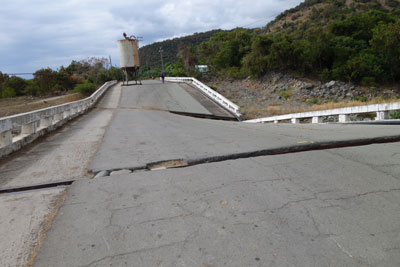
20. How closely did you stick to your original agenda?
We did the three loops that we planned, but within that context things changed considerably. A rigid plan in Cuba will break. But if you are creative, you can find alternative methods of achieving others things were are also great, and probably even better. Cuba is a non-linear adventure: embrace it.
For example: The second day we planned on going long, but instead did only a partial-day as we heard about a great ferry to a great island. On day four, we had hoped for a short ride south to hire a boat to take us to Isla Juventud. As we discussed our plans with the locals, they all, literally, laughed at us – “It is not possible. That is far. The boats would sink. Or the police would stop you. It is not safe or wise. Do not try it.”
We had considered doing day four and five as two days back to Havana, but we were charged up and hammered it in one mega day. We planned on taking the bus to Guantanamo, but the bus was full, so we hired the taxi. We considered going all the way to Baracoa, but we did not want to spend any more time in the car, and we heard reports of consistently heavy rain. We were unsure about the Sierra Maestra portion, but it worked out great – we rode strong, loved the scenery, loved the hike to Pico Torquino, had some great CPs, and enjoyed the Hotel Amigo.
For the third loop, we had planned on an extra day on the road, but we got ahead of schedule and then the Obama/Castro embargo-ending announcement (Dec 17) led us to hustle back to be part of the celebrations in Havana.
This combination of ‘overall goals tempered by local realities’ is one of the joys of travelling in Cuba.
21. Can you bike on the autopista?
Yes. It is a fast way to bridge certain areas. It is a flat, smooth road. That being said, it is not particularly exciting (about the same as biking a Western US section of interstate highway). It avoids the towns so that portion of the trip’s adventure is lost. Outside of Havana, it has little traffic. Amusingly, during a portion that we rode we happened to run into a semi-pro cycling group (can not be many of them in Cuba). I had been well trained to always want to bike on the shoulder, and they repeatedly gave me a friendly push to take up a full lane – “in Cuba, you bike in the lane, NOT on the shoulder.” The logic in this being that you’re far more likely to get a flat tire in the “bike” lane than you are getting hit by a car in the right traffic lane.
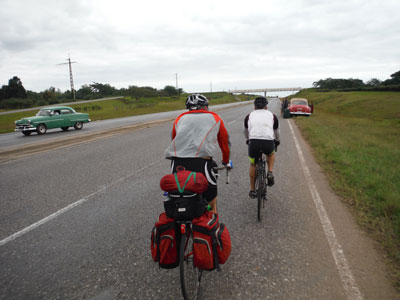
22. What are some additional places you would consider?
If we had more time, we probably would have gone to the far western tip (Punta El Cajon), to Holguin down to Baracoa, Isla de la Juventud, and the Archipeligo de Camaguey. It would also have been interesting to throw in a few rural all-dirt segments. It would have been fun to go to a baseball game in Santiago, or to participate in pick-up soccer games along the way. As an engineer, I wish I had gone on more factory tours, but most of the factories were simply closed. As much as we probed the Cuban health care system, it would have been great to line up even more healthcare visits.
23. What type of bike is best?
(Also see our GEAR PAGE.)
We rode cyclocross bikes, set up specifically for touring and would recommend the same. That being said, we’ve met people touring on all kinds of bikes, including many on mountain bikes. There is no question however that a properly set up cyclocross bike with the larger diameter 700c wheels will be a more efficient machine for covering miles than a smaller diameter (26”) fat tire mountain bike. We’ve even seen plenty of people touring on mountain bikes with front suspension, an inconceivably inefficient touring rig in our opinion, yet we’ve seen people do it.
24. What gear did you bring? What were you really glad you had, and what gear do you wish you brought?
(Also see our GEAR PAGE for very detailed information.)
In general, you don't need much. I have never travelled with so little gear. Compared to all of my previous trips, I was able to eliminate: cold weather gear, tent, pad, sleeping bag, front bags, stove, pots and pans/cooking gear.
When in doubt, you can bring it and then plan on giving it away after you feel things out.
Certainly, front and rear bags together are not necessary.
Note that our loaded bike weights (all gear, but no water or food) were 45 to 50 lbs. By comparison, when we biked to the Arctic Ocean and back in 1992, our loaded bike weights were 80 to 115 lbs. It is a great place to practice minimalism. You can travel light in Cuba!
25. How is Cuba for spare bike parts and repairs?
We never saw a bike store, though we met someone who had rented nice bikes in Havana (contact info below). The bikes there would, with very few exceptions, be considered not-rideable in the US – no lights, no reflectors, often with no brakes, no platforms on the pedal shafts, stretched chains that skips, crank arms that are skew, wheels that are dreadfully out of true, only a single functional gear-range…
There are “poncherias” in many towns – small bicycle fixit shops that primarily fix flat tires. They will likely have a few basic tools but by no means anything you should count on for serious repairs on a modern bike. I had a bottom bracket that was groaning and sounding like it might need tightening. In Sancti Spiritus, (relatively big town, state capitol) we were able to find a poncheria shop but they had nothing to pull cranks or tighten my BB.
Cuba lacks material goods. They blame the embargo (which is a cop-out for the party’s own failings), but, nevertheless, there simply are very, very, few things in the stores. Assume that you will be able to find no bike parts (insert picture here of the table of bike parts picture). Not little, but actually nothing. Maybe you will be surprised, but assuming that nothing is available it is the best starting point. With regard to repairs (as opposed to the procurement of new parts), Cubans are, by necessity, crafty repairmen, but best not to have that unintended adventure. Bring your own spare parts and know how to take care of your bike. Err on the side of a few too many parts – if you don't end up using them, they are happy to take your parts!
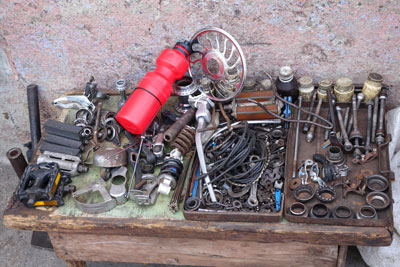
26. How many flats did you get?
We got none. We credit this to good, fresh tires (see our GEAR PAGE,) and a certain amount of luck. We each started with well-stocked patch kits and three tubes. Mid-way through the trip, it became clear that we would not need our nine tubes, so we started giving them away. It was amazing how thrilled people were to receive them.
27. Can you sell your bike there?
Yes, one could sell their bike there. Because there are so few things in stores, people are always trying to buy things from you – literally the clothes off of your back. You can sell your bicycle for about what you would sell it for in the US. This strategy makes the most sense if you don't want to travel back with your bicycle (for reasons of logistics or to avoid the potentially hefty bike shipping fees), or if you simply want to help the people of Cuba or like the idea of your bike living another life of its own on its next adventure, in Cuba.
28. Can you rent bikes in Cuba?
(Answer by Alex.) While we were pleased to ride on our own loyal steeds, it saves shipping hassle (and cost!) to rent bikes in Cuba. Clearly rentals make financial sense for shorter trips, and begin to make less financial sense for a longer trip.
Aaron paid $150 each way to ship his bike on United Airlines. Cubana was supposed to be an additional $50 each way, but they never charged us. United Airlines refused to ship my bike from SFO to Mexico because of the ‘embargo.’ NOT the embargo against Cuba, but the United Airlines embargo against large items during the months of holiday season. I had never heard of such a thing! Luckily, I was able to repackage my bike into two smaller boxes (no longer a bike box, now just ‘luggage’) and made another flight twelve hours later. Though Aaron was also on United, he had no such trouble. Rob flew on American Airlines and had no trouble but also had to pay $150 each way.
Much to our surprise, you can rent nice bikes in Cuba. We know of two sources:
1). We met a German couple that was riding nice bikes that they had rented in Havana from this company: http://www.profil-cuba-reisen.de/en/bike-rental-in-cuba
2). Upon our return, we became friends with a couple who bicycled with their son in Cuba in April 2016. They had a very positive experience. Details: Peter Marshall and Ana Maria Maza run the firm ‘CanBiCuba’ out of their Havana Café (‘Café Rueda’). Peter is from Scotland and Ana is Cuban. They do mostly guided group tours, but they also rent their high quality bikes. Peter is on Facebook and it says that he is over 70, but he is very fit!
Contact info:
Address: 611 Linea, Apto 2 , entree MyN, Vedada. It is very close to the National Hotel.
Ana’s email is: anamaria.maza@yahoo.es
Ana's Telephone is: 7-832-4869
Ana's cell in Canada is listed as: 1-905-360-0446
There is also an apartment next door for rent from Hectico and Diana. The apartment has private baths, a refrigerator and AC, and it goes for 30 CUC each. They were very nice, and they can hold gear (duffels / suitcases / extra clothes). Their son-in-law is a computer programmer and runs a taxi – he is helpful for both pick-up and drop off.
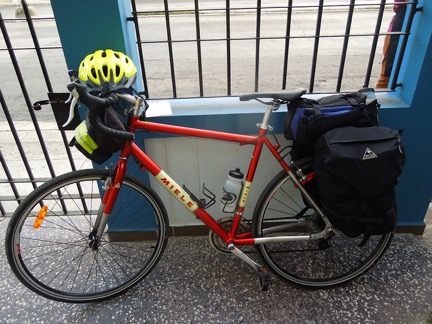
Rental bikes with bags that were brought from America.
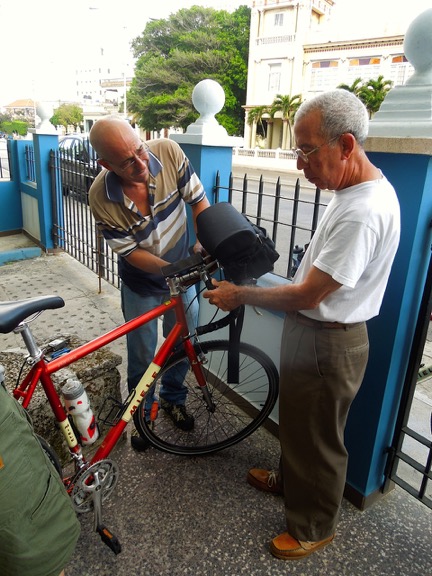
Gear being set-up.
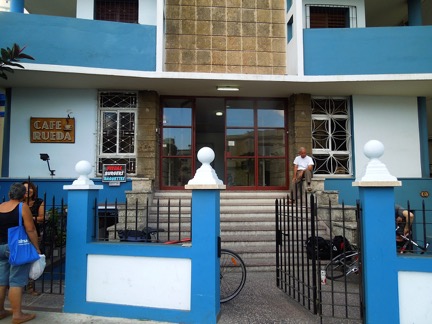
Café Rueda.
29. Can you use credit/debit cards?
In general, no. Bring cash. When we were there, American credit or debit cards were not recognized. As of this writing (April 2015) I think that has changed, if not, it soon will. Outside of the tourist areas, I don't think credit cards of any type would work. Bring cash. Canadian dollars and Euros were the currency of choice, and they can be converted in many locations. US dollars carried a conversion penalty.
30. Is it safe?
Yes. We felt entirely safe and had no problems. There is a real sense of community and it is a peaceful place. Political prisoners certainly exist - I wouldn't suggest being Cuban and speaking against Castro, but criminal activity appears very low. I think that is a combination of fear, and the positive result of a genuine communist we- are-in-this-together victory.
Relative to biking specifically, the roads are in good shape, no one is in a hurry, most of the cars can not go very fast, they genuinely share the road, no one is texting, and car ownership is meager (1/35th that of the U.S.).
31. How political is Cuba?
Politics are both everything and nothing in Cuba.
The newspaper’s masthead proudly touts ’50 years of the revolution.’ But, of course, revolutions can not last 50 years. Slogans are everywhere – on buildings, seemingly as graffiti, on billboards, painted on rocks… However, when you talk to people, they largely roll their eyes. They don't initiate conversation on the subject. It is tired and old. The real relevance to them is as it relates to their jobs and money. They are, generally, underutilized and desperately poor. If politics were to help bring a change, that is wonderful and they are all ears. But in and of itself, it simply means nothing relative to the daily challenge of getting the children clothed and food on the table.
32. Did the police hassle you?
No. Never. We travelled freely the entire time. In fact the opposite was true. Upon arrival we asked our cab driver who took us from the airport to the hotel whether the police would hassle us and he said, “Not a chance, they will make everything easier for you.”
Surprisingly that was the case. Once, while chatting with some locals on the street in Havana, the police came up and asked to see their identification, and didn’t even look at us. The police talked briefly with them and then they were told to leave and not bother us. I tried to tell the police that they weren’t bothering us but they’d already chased them off. Were they trying to protect us from the inevitable ask for money? Or were they trying to keep the locals from talking to foreigners about Cuban politics/life? We’ll never know. Another time in Havana we were walking late at night and a police officer was coming down the street toward us. As he approached I thought he was going to stop us but Aaron reached out and the guy “high-fived” him. We got a good laugh out of that afterward.
We did however find a reluctance among police to being photographed. We asked a couple of times and were met with a stern “No”.
33. How is pollution?
Pollution in Cuba is low. Our Lonely Planet Cuba book mentioned that Cuba won an award for being one of the world’s least polluted countries. Yes, but, part of that is due to the fact that it simply has minimal economic output.
We were along the coast, and the waters always looked pristine. Development is well below what we are used to as Americans. The most obvious exception is automobile emission control. In my life, in all of my travels around the world, I have never seen such heavily polluting cars. Nothing even 1/10th as bad. The old cars are charming and are an impressive feat of maintenance and successive wave of ingenious repairs, but these cars put out absolutely amazing amounts of thick black smog. As a cyclist, it was a real issue - you see it coming, you take a big breath before it hits, and you hold, hold, hold, hold, hold, hold, hold, hold your breath as long as you can, hoping that your intake exists by the time that you are past the big dark black cloud. Luckily, there aren’t a lot of cars on the road, particularly once you get out of the cities.
34. How is Cuba doing economically?
Cuba is, economically, a mess. The communist system sets up all sorts of rules that forbid all sorts of activities, thereby sucking the life out of people. There are few-to-no incentives for great work. They do not have entrepreneurs as role-models or heroes.
As an engineer, I was shocked by how little the country produces. People were constantly trying to buy our things – pants, shirts, gloves, bikes, tires, tubes, etc. Operational factories are very, very rare. Most are rusting hulks. We routinely heard the excuse ‘but we don't have much in the way of materials’, to which we always replied: “tell that to the Japanese or the Koreans. They have built amazing economies with precious few natural resources, beyond the freed ingenuity of their people.” The revolution pushed certain themes that were successful: sports, school, healthcare, community, environmental preservation – but there seems to be a complete lack of the theme of engineering industrial production.
Much labor is wasted (people chopping mile after mile of roadside grass, with a scythe, by hand). Investment in infrastructure and technology is low. The country also imports very little – the ports at Mariel (‘special economic development zone’ – Ha!) and Santiago had minimal activity. The country is poor – the majority of jobs are with the government, and it typically pays a meager $30 per month. Pay equality is the norm, so doctors seem to get paid the same as road workers. Feeding and clothing a family is a constant challenge.
Farming is remarkably ineffective, with the country near starvation. A gorgeous country endowed with enviable weather and land can barely feed itself. The country is on ration cards.
The country swaps its doctors for Venezuelan oil – if this falls apart with the increasing chaos in Venezuela, Cuba will be in huge trouble. Oil accounts for the vast majority of power in Cuba. There is a productive (and heavily polluting) nickel mine near Baracoa.
Tourism is a unique area of the economy, in that it is growing and affords direct contact with people who have a lot. As a result, there is a massive brain drain from every other sector (science, engineering, medicine, …) to tourism. A job in tourism, with direct contact with tourists, can easily pay 10x to 100x that of a ‘regular’ job. This area of the economy will skyrocket with the end of the US embargo, but this will not have the requisite broad effect on the economy. Tourism exists in only focal nodes. The pay it delivers is highly uneven.
Raul Castro has made it very clear that, despite the promised end of the embargo, Cuba is still very much a communist state, and he is still very much in control. Economically, Cuba faces a very long and hard road ahead.
35. How was the weather?
Great. It was typically in the 80s during the days. We typically hit the road at dawn (6:45 am start), which allowed us to get some nice cool morning miles, at the same time as children were walking to school. Seeing that activity, hearing them singing their songs, as the sun was starting its arc, was a great way to start the day. It was typically in the 60s at night. It never rained on us. Accentuating how moderate the weather is, the CPs typically had no glass windows – simply wooden slats. No heaters or air conditioners. In one, we asked for a blanket, and they looked at me quizzically: Why would you need that? Sheets alone are fine for the 60s.
36. What would you do when you would arrive at your day’s destination?
Typically at the end of each day’s ride our first and foremost objective was to locate a suitable Casa Particular for the night. First things first, we needed to find a place to stay -- until that was achieved, we didn’t do much else. There was no calling ahead for reservations, no booking ahead online, it was just rolling into town and keeping an eye out for houses with that familiar blue symbol out front, sometimes accompanied with the words “Rent Room”. We’d often roll into the center of town and hang out in the plaza while one or more of us went on little “recon” missions to check out potential rooms for the night. Once we’d secured a room for the night, we could relax a little bit. Showers, although never luxurious, were always appreciated. Once we were cleaned up and knew we had beds for the night we would usually visit with our host and then head into town to check the scene. There was almost always live music and plenty happening, and even though we stood out like space aliens, we learned to feel safe wandering the streets in the evenings. We didn’t need to go into a club to see nightlife, it was everywhere. We seldom stayed out late though as we were usually pretty tired from the day’s ride and wanted to be fresh to get an early start the next morning.
Cuba may have a crumbling infrastructure and a grossly underperforming economy, but it is a joy to visit. Its sense of community is a very real success (other successes we saw include its educational system, its sports (they fight notably above their weight), its environmental preservation (with cynicism noted) and their healthcare system (see Healthcare section of website). We love our American homes and communities, but we saw a real sense of community in Cuba that we simply do not find at home. Perhaps because people are lacking, they have come together. Doors are open. Kids play together. Music is emanating from so many sources. Their jobs typically don't push them very hard (‘they pretend to pay us and we pretend to work’), so no one looks stressed out. No one looks to be working late. No one is finishing up PowerPoints late at night. The central plaza usually has music every night. The towns are safe to walk through. Car ownership is low, so people meet more often, and a slower and more personal speed.
